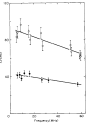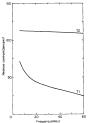In vivo measurements of NMR relaxation times
- PMID: 3831673
- PMCID: PMC2396278
- DOI: 10.1002/mrm.1910020102
In vivo measurements of NMR relaxation times
Abstract
A series of solenoidal NMR probes were built to measure T1 and T2 relaxation times in vivo in the mouse, over the frequency range of 5 to 60 MHz, using inversion-recovery and spin-echo pulse sequences. KHT tumors growing in the legs of C3H mice were studied and compared with normal mouse legs. The tumor relaxation times were studied at 10 MHz during the course of tumor growth and as a function of frequency when the tumor had a mass of approximately 0.9 g. Mouse legs with tumors have higher T1 and T2 values than those without tumors over the frequency range of 5 to 60 MHz. Significant changes in both relaxation times were detected before a palpable mass could be detected. T1 contrast between normal and tumor-bearing legs decreased with increasing frequency, while T2 contrast remained nearly constant. A comparison between in vivo and in vitro measurements was done using four different types of sample preparation: live mouse, dead mouse, excised whole mouse leg, and tissue sample. These studies showed small but significant differences between the relaxation times measured in vivo and those measured in vitro.
Figures










Similar articles
-
Continuous distributions of NMR relaxation times applied to tumors before and after therapy with X-rays and cyclophosphamide.Magn Reson Med. 1988 Jan;6(1):24-36. doi: 10.1002/mrm.1910060104. Magn Reson Med. 1988. PMID: 3352503
-
A review of 1H nuclear magnetic resonance relaxation in pathology: are T1 and T2 diagnostic?Med Phys. 1987 Jan-Feb;14(1):1-37. doi: 10.1118/1.596111. Med Phys. 1987. PMID: 3031439 Review.
-
Dual-frequency proton spin relaxation measurements on tissues form normal and tumor-bearing mice.J Natl Cancer Inst. 1976 Aug;57(2):389-93. doi: 10.1093/jnci/57.2.389. J Natl Cancer Inst. 1976. PMID: 1003519
-
NMR proton longitudinal relaxation times in tissues of the tumour-bearing C3H mouse studied as a function of frequency.Cancer Detect Prev. 1981;4(1-4):261-5. Cancer Detect Prev. 1981. PMID: 7349784
-
Nuclear magnetic resonance in oncology.Semin Nucl Med. 1985 Apr;15(2):210-23. doi: 10.1016/s0001-2998(85)80027-1. Semin Nucl Med. 1985. PMID: 3890188 Review.
Cited by
-
Iron overload cardiomyopathies: new insights into an old disease.Cardiovasc Drugs Ther. 1994 Feb;8(1):101-10. doi: 10.1007/BF00877096. Cardiovasc Drugs Ther. 1994. PMID: 8086319 Review.
-
Application of machine learning algorithms for multiparametric MRI-based evaluation of murine colitis.PLoS One. 2018 Oct 26;13(10):e0206576. doi: 10.1371/journal.pone.0206576. eCollection 2018. PLoS One. 2018. PMID: 30365545 Free PMC article.
References
-
- BLOEMBERGEN N, PURCELL EM, POUND RV. Phys. Rev. 1948;73:679.
-
- HELD G, NOACK F. Z. Naturforsch. C. 1973;28:59. - PubMed
-
- KOENIG SH, BROWN RD, III, ADAMS D, EMERSON D, HARRISON CG. Invest. Radiol. 1984 in press. - PubMed
-
- ABRAGAM A. The Principles of Nuclear Magnetism. Oxford Univ. Press; (Clarendon), Oxford: 1961. pp. 82–83.
-
- HILL HDW, RICHARDS RE. J. Phys. E. 1968;1:977.
Publication types
MeSH terms
Grants and funding
LinkOut - more resources
Full Text Sources

